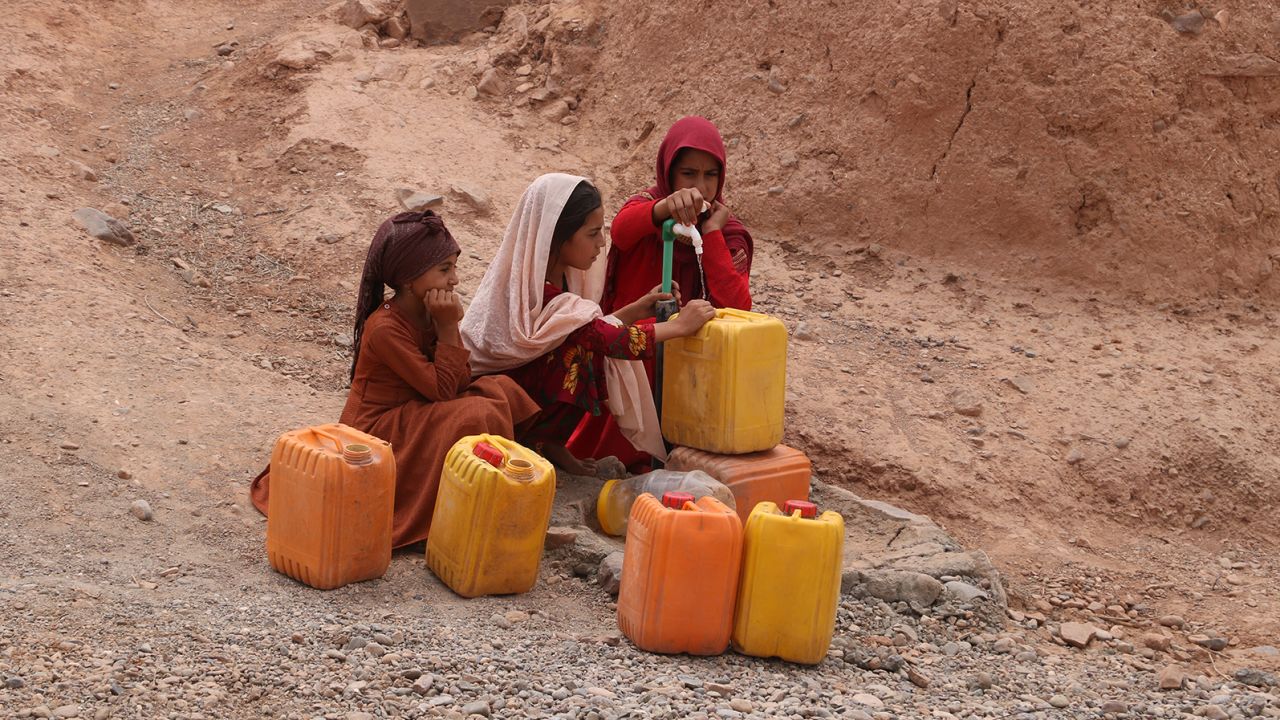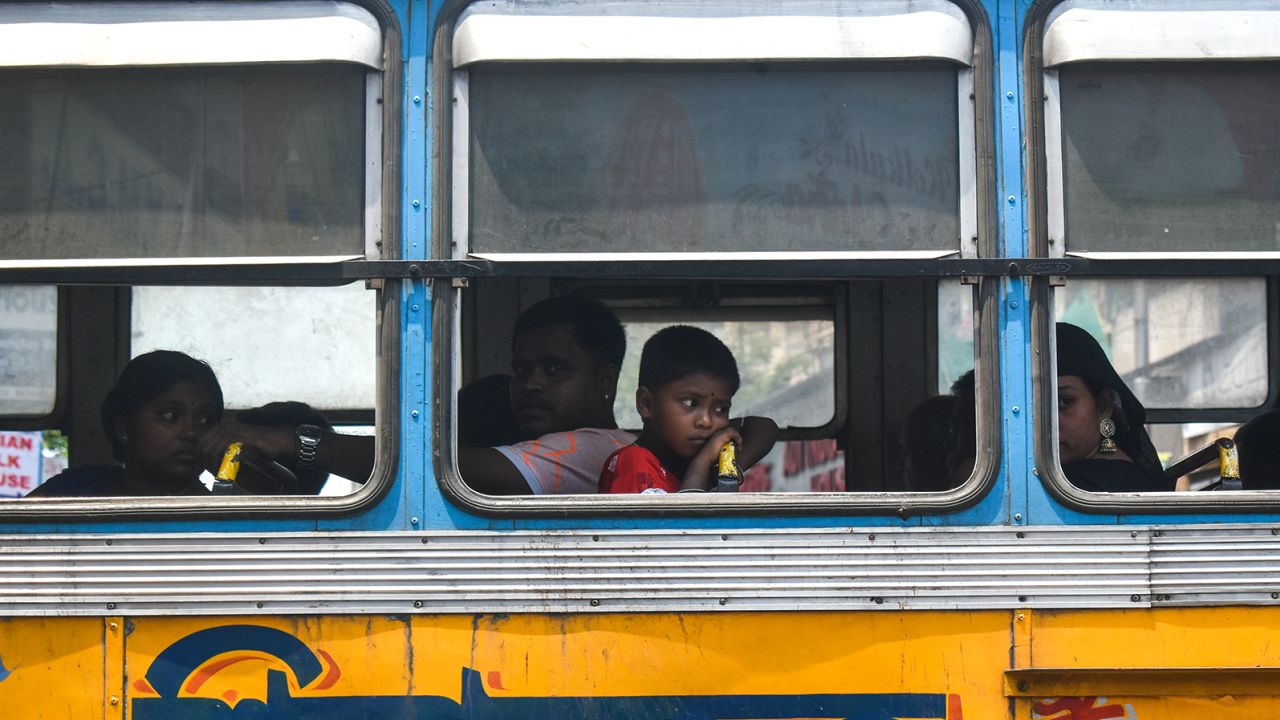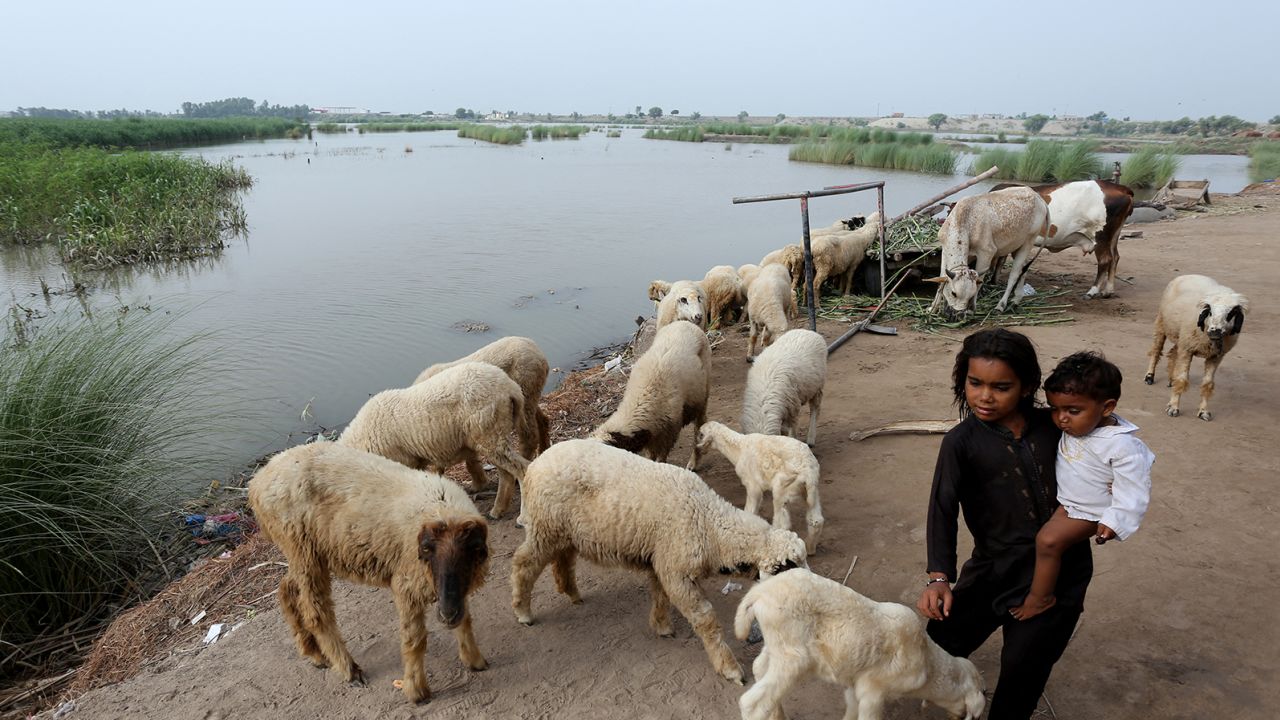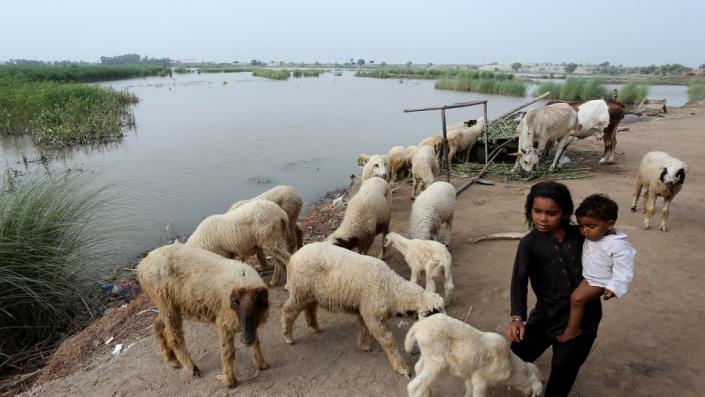Watch CBS News
Be the first to know
Get browser notifications for breaking news, live events, and exclusive reporting.
Watch CBS News
Be the first to know
Get browser notifications for breaking news, live events, and exclusive reporting.
Watch CBS News
Be the first to know
Get browser notifications for breaking news, live events, and exclusive reporting.
Watch CBS News
Be the first to know
Get browser notifications for breaking news, live events, and exclusive reporting.
Watch CBS News
Be the first to know
Get browser notifications for breaking news, live events, and exclusive reporting.
Watch CBS News
Be the first to know
Get browser notifications for breaking news, live events, and exclusive reporting.
CNN
—
Nearly half a billion children in South Asia are exposed to extreme high temperatures as life-threatening heat waves caused by the climate crisis become stronger and more frequent, according to the United Nations’ children’s agency.
In a news release Monday, UNICEF said its analysis of 2020 data showed an estimated 460 million children in countries including Afghanistan, India and Pakistan were exposed to temperatures where 83 or more days in a year exceeded 35 degrees Celsius (95 Fahrenheit) – making South Asia the hardest-hit region for those under age 18.
The analysis showed 76% of children in South Asia were exposed to extreme high temperature compared to 32% globally, UNICEF said.
“Countries in the region are not the hottest in the world right now but the heat here brings life-threatening risks for millions of vulnerable children,” said Sanjay Wijesekera, UNICEF regional director for South Asia. “We are particularly concerned about babies, toddlers, malnourished children and pregnant women as they are most vulnerable to heat strokes and other serious effects.”
Temperatures in some parts of India soared to 47 degrees Celsius (116 Fahrenheit) in June, killing at least 44 people and sickening hundreds with heat-related illnesses.
Some cities in Pakistan also saw similarly high temperatures the same month, raising fears especially for laborers who spend hours toiling outdoors and for poor populations with little to no cooling options.
In parts of the country’s southern Sindh province, about 1.8 million people were exposed to temperatures of 40 degrees Celsius (104 F) and higher, UNICEF said, giving rise to short and long-term health risks, including dehydration and organ failure.

UNICEF warns the situation is exacerbated for children as they are unable to quickly adapt to such temperature change.
The risks can be life threatening – from fainting and poor mental development to neurological dysfunction, seizures and cardiovascular diseases.
Pregnant woman are particularly susceptible to heat and can experience preterm births and stillbirths, UNICEF said.
Experts say the climate crisis is only going to cause more frequent and longer heat waves in the future, testing the region’s ability to adapt.
India, the world’s most populous nation of 1.4 billion, often experiences heat waves during the summer months of May and June, but in recent years, they have arrived earlier and become more prolonged.
In April 2022, India experienced a heat wave that saw temperatures in the capital New Delhi exceed 40 degrees Celsius for seven consecutive days. In some states, the heat closed schools, damaged crops and put pressure on energy supplies, as officials warned residents to remain indoors and keep hydrated.

Experts have also warned the threat facing Afghanistan is particularly stark. Not only is there high potential for record extreme heat, the impacts are compounded by dire social and economic problems.
At the same time, extreme weather has had a deadly impact in other parts of the region.
Flooding caused by record monsoon rains and melting glaciers in Pakistan submerged a third of the country last year, killing nearly 1,600 people – more than a third of whom were children.

While the water washed away homes and destroyed villages, water-related ailments began infecting children, giving rise to a new disaster in the nation of 230 million.
In its report, UNICEF warned that ultimately children, adolescents and women are among those who pay the highest price for extreme weather events.
“Young children simply cannot handle the heat,” Wijesekera said. “Unless we act now, these children will continue to bear the brunt of more frequent and more severe heat waves in the coming years, for no fault of theirs.”
Nearly half a billion children in South Asia are exposed to extreme high temperatures as life-threatening heat waves caused by the climate crisis become stronger and more frequent, according to the United Nations’ children’s agency.
In a news release Monday, UNICEF said its analysis of 2020 data showed an estimated 460 million children in countries including Afghanistan, India and Pakistan were exposed to temperatures where 83 or more days in a year exceeded 35 degrees Celsius (95 Fahrenheit) – making South Asia the hardest-hit region for those under age 18.
The analysis showed 76% of children in South Asia were exposed to extreme high temperature compared to 32% globally, UNICEF said.
“Countries in the region are not the hottest in the world right now but the heat here brings life-threatening risks for millions of vulnerable children,” said Sanjay Wijesekera, UNICEF regional director for South Asia. “We are particularly concerned about babies, toddlers, malnourished children and pregnant women as they are most vulnerable to heat strokes and other serious effects.”
Temperatures in some parts of India soared to 47 degrees Celsius (116 Fahrenheit) in June, killing at least 44 people and sickening hundreds with heat-related illnesses.
Some cities in Pakistan also saw similarly high temperatures the same month, raising fears especially for laborers who spend hours toiling outdoors and for poor populations with little to no cooling options.
In parts of the country’s southern Sindh province, about 1.8 million people were exposed to temperatures of 40 degrees Celsius (104 F) and higher, UNICEF said, giving rise to short and long-term health risks, including dehydration and organ failure.

UNICEF warns the situation is exacerbated for children as they are unable to quickly adapt to such temperature change.
The risks can be life threatening – from fainting and poor mental development to neurological dysfunction, seizures and cardiovascular diseases.
Pregnant woman are particularly susceptible to heat and can experience preterm births and stillbirths, UNICEF said.
Experts say the climate crisis is only going to cause more frequent and longer heat waves in the future, testing the region’s ability to adapt.
India, the world’s most populous nation of 1.4 billion, often experiences heat waves during the summer months of May and June, but in recent years, they have arrived earlier and become more prolonged.
In April 2022, India experienced a heat wave that saw temperatures in the capital New Delhi exceed 40 degrees Celsius for seven consecutive days. In some states, the heat closed schools, damaged crops and put pressure on energy supplies, as officials warned residents to remain indoors and keep hydrated.

Experts have also warned the threat facing Afghanistan is particularly stark. Not only is there high potential for record extreme heat, the impacts are compounded by dire social and economic problems.
At the same time, extreme weather has had a deadly impact in other parts of the region.
Flooding caused by record monsoon rains and melting glaciers in Pakistan submerged a third of the country last year, killing nearly 1,600 people – more than a third of whom were children.

While the water washed away homes and destroyed villages, water-related ailments began infecting children, giving rise to a new disaster in the nation of 230 million.
In its report, UNICEF warned that ultimately children, adolescents and women are among those who pay the highest price for extreme weather events.
“Young children simply cannot handle the heat,” Wijesekera said. “Unless we act now, these children will continue to bear the brunt of more frequent and more severe heat waves in the coming years, for no fault of theirs.”
For more CNN news and newsletters create an account at CNN.com
The last eight years have been the hottest years ever measured on the planet, according to the World Meteorological Organization; July was the hottest month ever recorded; July 6 was the hottest day. All over the planet, the heat broke temperature records, including in Siberia, where the thermometer hit 103 degrees!
More than half the U.S. population was subject to heat warnings in July. In Phoenix, Arizona, the heat has broken all kinds of records, including the longest streak of consecutive days (31, from June 30 to July 30) where the temperature hit 110 degrees or hotter.
And it’s not just the hot air that’s dangerous; it’s the surfaces. Using a non-contact infrared thermometer, Pogue measured the temperature of the steering wheel of a car: 162.5° Fahrenheit. A sidewalk was 144°F – hot enough to burn your dog’s paws in 60 seconds. And a playground slide for children was 182.8°F.
“I actually have mittens in my car so that when the steering wheel gets really hot, I put my mittens on, and that’s how I drive,” said Melissa Guardaro, an extreme-heat researcher at Arizona State University.
Pogue said, “You know you’re living in a hot place when you have to keep oven mitts in your glove compartment!”
“Yeah! Probably not in the glove compartment, because you can’t touch the metal tab.”
According to Guardaro, Phoenix hospitals have seen a rise in admissions for heat stress – the most they’d ever had. “People say, ‘Oh, you live in Phoenix, it’s a dry heat.’ And honestly, 100°, 105° is not bad,” she said. “But I want to stress very strongly, nobody is acclimated to 115, 118 degrees.”
So, why is so much of the country scorching for so long? It’s thanks to the “heat dome.” It’s an area of high pressure, way up high, that traps warm air like the lid on a pot. It traps the heat, it stops rain from moving in to cool us off, and it just sits there. Unfortunately, not every area under the heat dome suffers equally.
CBS News
Cities get the worst of it, according to Becca Benner, director of climate issues at the nonprofit Nature Conservancy. “Cities are where heat comes to stay and comes to live,” she said. “Cities, on average, are several degrees warmer than the surrounding areas. Just because of so much pavement, it tends to absorb heat better and reflect heat better.”
It’s called the “urban heat island effect”: too much pavement, and not enough trees and greenery to cool things off. The heat island effect is worst in the poorer areas of our cities, where there aren’t many trees, and even the bus stops don’t always offer shade.
Carlos Galves lives in Phoenix without air conditioning, electricity, or even running water. The thermometer on his wall registers 109°F. When asked if he is able to sleep in this heat, he replied, “I sleep for half an hour, then I’ll lie awake for an hour after that, because it’s just so hot.”
He said to stay cool at home he drinks a lot of water. “And twice a day I pour a bucket of water on myself, and I just try to rest in the evening,” he said.
In Phoenix, you can get free transportation to the city’s 90 cooling centers. But ever since he collapsed from the heat last month, Galves is worried about leaving his house: “I’m afraid I could faint again if I go out during the day. So, I wait ’til the sun is going down to go out to get ice or water.”
Even for people who have conditioning, not everyone can afford to use it; the average monthly bill for A/C in Phoenix is more than $450 a month. Guardaro said, “We have a group of people who have to make very difficult choices. Do I pay for air conditioning, or do I pay for my rent? This kind of heat wave is bringing up all the chinks in the infrastructure.”
Last month, President Biden announced some small steps toward adapting to dangerous heat, like expanding access to drinking water, improving weather forecasts, and setting up a heat alert system. But Guardaro maintains that there’s much more to be done. City planners should develop heat infrastructure (like cooling centers and strategic greenery), and the federal government should start taking heat as seriously as it treats other climate disasters. For example, FEMA has never declared extreme heat as a disaster.
Pogue asked, “So, flooding and hurricanes, all those things would be designated federal disaster areas, but not heat?”
“Not heat,” Guardaro replied. “Standing up more cooling centers, providing greater services for people – that is not reimbursed by the government, because there has never been a FEMA extreme-heat-declared disaster.
“Extreme heat is the climate disaster that kills the most people,” she said. “In fact, it kills more people than all of the other disasters combined. And we kind of have a joke here that we show a picture of before a heat wave, and then we show a picture after a heat wave, and it’s the same picture. And that’s part of the problem, because people see tornadoes and houses are upended and hurricanes and trees and utility poles. [Heat] is this invisible killer.”
Of course, heatwaves aren’t the only result of the warming planet. Heat also dries out vegetation, and we get fires. Heat evaporates the land, so we get droughts. Heat evaporates the oceans, so we get hurricanes.
The Nature Conservancy’s Becca Benner cautions us not to think of this summer’s heat as something freakish and rare; it’s the new normal. “It is no longer a future threat; we are living this now,” she said. “So, whether your basement just flooded, whether you just had to evacuate for a fire, whether it’s too hot for you to go outside and enjoy yourself, that means we are now experiencing some of the impacts of climate change. We have to reduce emissions. And we have to do it immediately, and faster.”
For more info:
Story produced by Robert Marston. Editor: Carol Ross.
See also:

Iran announced a nationwide two-day holiday because of increasing temperatures, state media reported Tuesday.
Government spokesperson Ali Bahadori Jahromi said the decision to close governmental offices, banks and schools on Wednesday and Thursday came after the health ministry warned about a possible increase in cases of heat exhaustion because of high temperatures, the official IRNA news agency reported.
In recent days, cities and towns in Iran saw temperatures around 104 degrees Fahrenheit. The capital, Tehran, experienced 100.4 F on Tuesday.
The metrological office predicted Tehran would see temperatures of 102.2 F over the next three days.
Ahvaz, the capital of an oil-rich province in the country’s southwest, experienced 122 F on Tuesday.
In 2022, Iran registered its hottest temperature at 127.4 F in Ahvaz.
Earth’s hottest day in modern history was likely July 4, when the average global temperature reached 62.9 degrees Fahrenheit. It was mainly blamed on climate change and emerging El Nino pattern.
The highest registered air temperature on Earth is 134 F, recorded July 10, 1913, in Death Valley in the United States.
The kind of extreme heat scorching the U.S. this summer isn’t just uncomfortable — it also makes workers less productive and costs the U.S. billions of dollars in lost economic activity.
Labor-intensive outdoor professions are most exposed to the debilitating effects of soaring temperatures, while excessive heat can also impair workers’ cognitive abilities, research shows. Such weather can increase absenteeism and lead workers to quit early, reducing the number of hours spent on the job, according to the 2023 study by Chinese researchers.
Exposure to temperatures greater than 85° Fahrenheit leads workers to reduce their workdays by an average of one hour, compared to when air temperatures are 76–80°F, a separate study shows. And as climate change drives more extreme weather, productivity losses are expected to intensify over time, experts warns.
Heat can affect a wide range of jobs, from agricultural workers to those who work in factories, warehouses and restaurants as well as airline, telecom, delivery and home health workers New York Times reporter Coral Davenport told CBS News. When workers are fatigued and their output drops, their employers take a hit, while there can be other risks.
“Medical researchers have known for decades that when workers are exposed to high heat — over 85 degrees, over 95 degrees — that they are more likely to make mistakes, have injuries, work more slowly,” Davenport said. “But something that economic researchers have only just started to put together is that this really has a major impact broadly across the economy for those reasons.”
Even if a workplace like a restaurant is air conditioned, heat coming from the kitchen can make chefs more injury prone, according to R. Jisung Park, a labor economist and assistant professor at the University of Pennsylvania.
“We have a ‘just right’ zone where we perform optimally. When you push us beyond that zone, the body tries to maintain stability, but it’s more taxing and we make more mistakes,” Park told CBS MoneyWatch.
Other workplaces are simply much harder to cool. That said, mitigating the heat’s impact on labor productivity is challenging.
“Air conditioning isn’t the obvious answer because there are some workplaces where it’s very expensive or impossible, so we need to get creative,” Park said. “Even some warehouses are really big — they’re indoors, but there are so many openings for trucks to load and unload.”
A recent study by researchers with the Adrienne Arsht-Rockefeller Foundation Resilience Center estimated that high heat costs the U.S. $100 billion annually in reduced productivity, a figure expected to double by 2030. Such daunting figures exclude related hits from factors including a decrease in tourism and rising health and energy costs.
Employers must also make costly investments to adjust their business to account for the rising mercury, including in air conditioning. That can take a particular toll on small and midsize businesses.
“It’s easily a couple millions dollars investment, and that is not an investment a lot of employers feel like they’re able to make,” Davenport said.
The federal Occupational Safety and Health Administration is working on developing a set of national standards that would institute protections for workers exposed to heat. Some business groups have opposed the effort, citing the costs of such remedial measures.
“It would probably include things like mandatory rest, mandatory water, potentially requiring some employers to install air conditioning,” Davenport said. “And already a lot of business groups have come out against it and said, ‘This is going to be too much, this could impose big costs on businesses.’ So that debate is happening.”